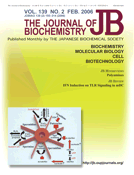-
Views
-
Cite
Cite
Yasuyuki Shitomi, Tohru Hayakawa, Delwar M. Hossain, Masahiro Higuchi, Kazuhisa Miyamoto, Kazuko Nakanishi, Ryoichi Sato, Hidetaka Hori, A Novel 96-kDa Aminopeptidase Localized on Epithelial Cell Membranes of Bombyx mori Midgut, Which Binds to Cry1Ac Toxin of Bacillus thuringiensis, The Journal of Biochemistry, Volume 139, Issue 2, February 2006, Pages 223–233, https://doi.org/10.1093/jb/mvj024
Close - Share Icon Share
Abstract
Proteins in the brush border membrane (BBM) of the midgut binding to the insecticidal Cry1Ac toxin from Bacillus thuringiensis were investigated to examine the lower sensitivity of Bombyx mori to Cry1Ac, and new aminopeptidase N that bound to Cry1Ac was discovered. DEAE chromatography of Triton X-100−soluble BBM proteins from the midgut revealed 96-kDa aminopeptidase that bound to Cry1Ac. The enzyme was purified to homogeneity and estimated to be a 96.4-kDa molecule on a silver-stained SDS-PAGE gel. However, the native protein was eluted as a single peak corresponding to ∼190-kDa on gel filtration and gave a single band on native PAGE. The enzyme was determined to be an aminopeptidase N (APN96) from its substrate specificity. Antiserum to class 3 B. mori APN (BmAPN3) recognized APN96, but peptide mass fingerprinting revealed that 54% of the amino acids of matched peptides were identical to those of BmAPN3, suggesting that APN96 was a novel isoform of the APN3 family. On ligand blots, APN96 bound to Cry1Ac but not Cry1Aa or Cry1Ab, and the interaction was inhibited by GalNAc. KD of the APN96−Cry1Ac interaction was determined to be 1.83 ± 0.95 μM. The lectin binding assay suggested that APN96 had an N-linked bi-antennal oligosaccharide or an O-linked mucin type one. The role of APN96 was discussed in relation to the insensitivity of B. mori to Cry1Ac.





